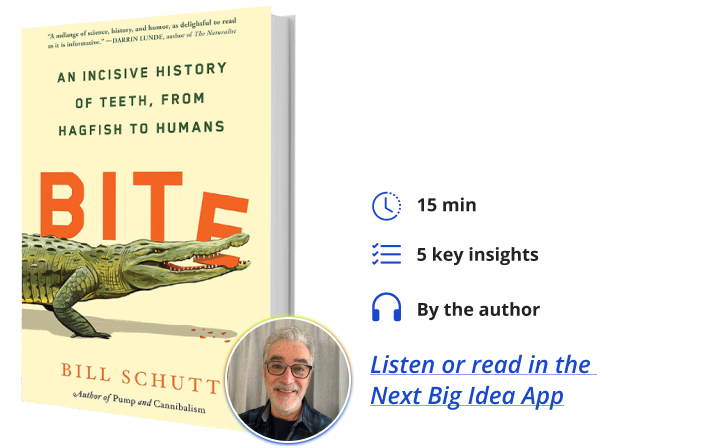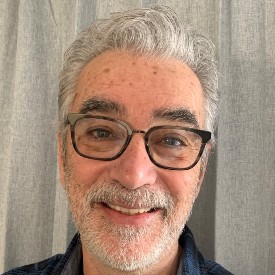Bill Schutt is a zoologist and the author of popular science books, including Cannibalism: A Perfectly Natural History and Pump: A Natural History of the Heart. He is an Emeritus Professor of Biology at LIU Post and a research associate at the American Museum of Natural History. His research has been featured in Natural History, the New York Times, Newsday, The Economist, and Discover.
Below, Bill shares five key insights from his new book, Bite: An Incisive History of Teeth, from Hagfish to Humans. Listen to the audio version—read by Bill himself—in the Next Big Idea App.

1. The evolution of teeth has been key to the success of vertebrates.
There are two hypotheses concerning tooth origins: One is that they evolved from bony bumps or scales on the outside of some ancient fish body. Over many generations, some of these bumps gradually migrated into the mouth, eventually taking on new roles as teeth. Hypothesis two is that teeth evolved from bony bumps located inside some ancient fish’s bodies, which eventually moved into the mouth.
While the jury is still out, the outside-to-in hypothesis has more evidence to back it. However, some scientists think both hypotheses might be right, in which case teeth might have evolved on separate occasions by different means. We should remember that even the strongest hypothesis is subject to tweakage or major modification.
Regardless of what teeth were doing before they were teeth, once teeth appeared on the scene, they evolved rapidly, taking on a variety of shapes, sizes, and numbers. At first in the ocean, and then (as some vertebrates began exploring the land), teeth and the jaws that held them in place enabled myriad creatures to chow down in every new environment they encountered and on every form of nutrition. Though there were certainly additional adaptations contributing to the success of vertebrates (like the chain-link backbone that gives them their name), teeth are certainly near the top of that list.
2. Teeth evolved into a dizzying array of forms.
Some vertebrates evolved teeth associated with highly specialized diets, enabling them to feed on things other animals can’t. The teeth of horses are long and continue to grow over the animal’s life. This means horses can process tough-to-digest grass, which would otherwise grind shorter, nongrowing teeth down to the nub.
Vampire bats have ultra-sharp incisors and canines that allow them to inflict painless bites on their sleeping or oblivious prey. Fangs are specialized teeth used in predation, self-defense, or display. A six-foot Gaboon viper can have fangs up to two inches in length. Connected to venom glands in the snake’s skull, these are the “original” hypodermic needles, delivering enough venom to kill thirty full-grown adult humans. On the plus side, venom-derived medications (like the antihypertensive captopril) save thousands of lives each year. The medical benefits from animal venoms and toxins (most of which have yet to be studied) are reasons to be careful not to drive some creatures to extinction just because they’re potentially harmful to us.
“Once teeth appeared on the scene, they evolved rapidly, taking on a variety of shapes, sizes, and numbers.”
Tusks are modified incisors or canines found in elephants, walruses, pigs, and some species of deer. Narwhals possess a single, clockwise-spiraling tusk that they use during jousting and as a sensory organ, thought to provide them with information on water salinity—handy when searching for breaks in the arctic ice through which they can surface and breathe.
Other vertebrates experienced different dental destinies. Rather than dietary specialists, omnivores can exist on a variety of food types. Plants, meat, you name it—these opportunists can pound it down. Omnivores and their versatile Swiss Army teeth have an edge when environments change, food gets scarce, or competition with other species gets serious.
3. Fossilized teeth reveal more than just information about ancient animals.
Although probably 99 percent of all the vertebrate species that ever lived are now extinct, their teeth often live on as fossils. Teeth are the most common fossil because teeth are composed of the bony material dentin covered by the hardest substance found in the vertebrate body: a mineral salt called enamel. Teeth also have microscopically small pores on their surface. After teeth get buried by sediment, water can seep into their pores, carrying minerals that eventually solidify and make the fossil teeth even harder and more resistant to the elements. It also helps that extinct animals (like dinosaurs), as well as sharks and alligators, could grow and shed hundreds and even thousands of teeth over a lifetime—a fact that often compels fossil collectors to break out in a happy dance.
Because of their durability and relative abundance in the fossil record, teeth have been vitally important in identifying many new species of extinct vertebrates. In some instances, teeth are the only evidence that these creatures ever existed.
Scientists, though, are now utilizing both fossilized and modern teeth to tell stories that go beyond the identification of their owners. Teeth provide researchers with information on diet, ecology, climate change, and weather patterns that existed while the tooth owner was chomping away. The tales told by teeth often include human characters. In these instances, teeth have been especially helpful in recording disease conditions that affect teeth (like syphilis) and providing clues about periods of famine and war.
4. George Washington, who had but a single tooth when he became President, owned at least four sets of dentures over his adult life.
Okay, let’s get this out of the way right up front. There is absolutely no evidence that any of the uncomfortable contraptions George Washington wore in his mouth were made of wood. Even so, the story of Washington’s dismal dentition is both fascinating and controversial.
In the mid-to-late 18th century, ivory turners and metalsmiths were enlisted to create tooth replacements more frequently than ever before. There was a dramatic increase in both cavities and tooth loss, which coincided with the newly widespread use of refined sugar. The establishment of sugar plantations also tracked the rise of dentistry as a profession.
However, dental appliances did not originate in Europe or the colonies. Instead, the first evidence of their existence dates to pre-Roman times by the Etruscans, who lived in what is now Italy and who had some flamboyant customs related to mouth bling.
“There is absolutely no evidence that any of the uncomfortable contraptions George Washington wore in his mouth were made of wood.”
By George Washington’s time, dentures sold by dentistes or surgeon dentists were composed of different combinations of wire, metal springs, rivets, and lead. The teeth were usually carved from those formerly residing in animal mouths: cows and horses were popular, but elephant tusks were also used, as were those of hippos. Some of these dentures also contained human teeth purchased from poor people who had them yanked out without anesthesia, as depicted in Victor Hugo’s Les Misérables. Teeth were also extracted from the recently deceased, like those stolen from the battlefield dead. In early 19th century Europe, these became known as Waterloo teeth after the famous battle.
There is actually a recent and serious controversy over the origin of the human teeth found in George Washington’s dentures—four pairs of which survive today. Washington held several hundred enslaved people at his plantation in Mount Vernon, and some of them apparently sold teeth to local dentists—including Washington’s.
5. Visiting the dentist will become less necessary and less scary.
Advancing dental therapies related to stem cells, gene therapy, and new medications may soon make unpleasant dental procedures obsolete. For example, in Japan, human trials will begin in the fall of 2024 on an experimental drug believed to regenerate missing teeth or stimulate them to grow in instances where they’ve failed to emerge.
Elsewhere, researchers are working to make composite tooth fillings unnecessary by using regenerative fillings. These are designed to stimulate native stem cell populations in a patient’s jaw to repair and regrow dentin and enamel in damaged tooth regions.
Other researchers are examining baby teeth that have fallen out. They hope to provide professionals with an early warning system that can serve as a predictor of mental disorders that could potentially show up during adolescence.
Finally, scientists are exploring the connection between the presence of a common tooth and gum-related bacterium and the occurrence of Alzheimer’s disease. The thought here is that the bacteria invade the brain, where they release chemicals called gingipains—an enzyme that breaks down proteins. Some researchers believe that gingipains are also involved in the production of amyloid plaques—the hard clumps of misfolded protein that accumulate in the brain, disrupting its function in Alzheimer’s patients. Stay tuned.
To listen to the audio version read by author Bill Schutt, download the Next Big Idea App today:





























